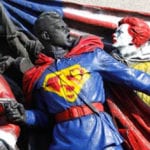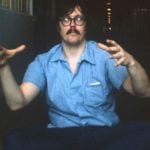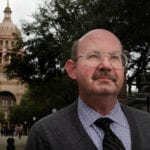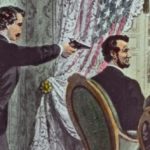 Weird Stuff
Weird Stuff  Weird Stuff
Weird Stuff  Animals
Animals 10 Inspiring Tales of Horses Being Human
 Mysteries
Mysteries Top 10 Haunting Facts About the Ghost Ship MV Alta
 History
History 10 Surprising Stories About the Texas Rangers
 Humans
Humans 10 Philosophers Who Were Driven Mad by Their Own Theories
 Miscellaneous
Miscellaneous 10 Video-Game-Worthy Weapons and Armors from History
 Weird Stuff
Weird Stuff 10 Psychics Who Accurately Predicted Wartime Events
 The Arts
The Arts 10 Pieces of Art Inspired by a Broken Heart
 Health
Health 10 Science Fiction-Sounding New Medical Treatments
 History
History 10 Surprising Facts About the Father of Submarine Warfare
 Weird Stuff
Weird Stuff 10 Times Real Laws Were Based on Bizarre Hypotheticals
 Animals
Animals 10 Inspiring Tales of Horses Being Human
 Mysteries
Mysteries Top 10 Haunting Facts About the Ghost Ship MV Alta
Who's Behind Listverse?

Jamie Frater
Head Editor
Jamie founded Listverse due to an insatiable desire to share fascinating, obscure, and bizarre facts. He has been a guest speaker on numerous national radio and television stations and is a five time published author.
More About Us History
History 10 Surprising Stories About the Texas Rangers
 Humans
Humans 10 Philosophers Who Were Driven Mad by Their Own Theories
 Miscellaneous
Miscellaneous 10 Video-Game-Worthy Weapons and Armors from History
 Weird Stuff
Weird Stuff 10 Psychics Who Accurately Predicted Wartime Events
 The Arts
The Arts 10 Pieces of Art Inspired by a Broken Heart
 Health
Health 10 Science Fiction-Sounding New Medical Treatments
 History
History 10 Surprising Facts About the Father of Submarine Warfare
10 Murderers With Their Own Monuments
It’s inevitable that we will always want to commemorate our renowned men and women by building monuments to them. The monument is a sign that the person is honored and remembered. It’s also just as inevitable that we remember the notorious evildoers of history—either out of a sense of justice, a wish to prevent future horrors, or simple morbid fascination. But what if some of these saviors and scoundrels were the same people?
Rarely is history divided neatly into spotless saints and vicious villains. Sometimes, those we lionize have dark deeds lurking in their pasts. The polished stone of some monuments hides such darkness. At best, these memorials seek to recognize the achievements of a person in spite of their misdeeds, overlooking the vices while celebrating the virtues. At worst, the statues’ builders put them up with full knowledge of the figure’s crimes—with some monuments raised on the very bloodstained ground where the victims perished.
Read on for the following murderers immortalized in stone and metal . . .
10 Nathan Bedford Forrest
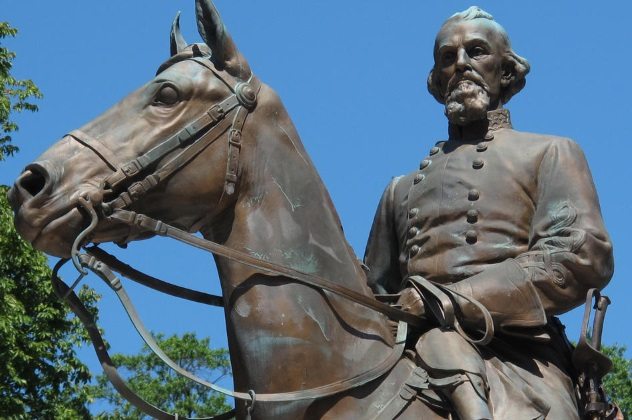
The Murderer:
In the mid-19th century, a longstanding national dispute over the future of black slavery in the United States erupted into the Civil War. The slaveholding Confederacy was determined to keep its traditional rights, even if it had to form its own nation to do so; the Union was equally determined to keep the US together and eventually ensured that slavery was abolished. They even recruited former slaves to fill out the ranks of the US Army.
Confederate generals from the US Civil War weren’t all cut from the same cloth—they ranged from diehards who never gave up on their lost cause to those who worked for reunion and reconciliation after the war ended. General Nathan Bedford Forrest falls on the dark end of the spectrum. A tenacious fighter, he was equally tenacious and uncompromising in his views of black Americans. He had been a slave trader before the war, something considered a disreputable profession even in the prewar South. After the war, he was instrumental in organizing the Ku Klux Klan. He was no gentleman.
The Mayhem:
Forrest’s biggest act of notoriety came during the war at Fort Pillow, Tennessee. The fort was held by Union troops, many of them black men. The Southerners as a whole, having lived for generations in fear of blacks gaining weapons, found the idea of such soldiers to be repugnant. Their government had even announced that captured black soldiers would be kept as slaves or executed. These threats were largely for nothing, since the US government vowed to enslave or kill Southern prisoners in retaliation, and a stalemate ensued. Forrest, though, acting on his own initiative out in the field, allowed a far uglier outcome to play out.
Forrest’s men, having besieged the fort for hours, finally managed to storm it when the defense collapsed. The defenders—white and black Union soldiers together—threw down their weapons, expecting to be taken prisoner. The white ones were.
The black soldiers, however, were massacred wholesale. Surrendering troops were killed by the dozens, their killers deaf to their cries for mercy. Many fled to the banks of the Mississippi River, where Forrest’s men bayoneted them in droves. As Forrest put it in his after-action report: “The river was dyed, with the blood of the slaughtered for two hundred yards. The approximate loss was upward of five hundred killed, but few of the officers escaping. [ . . . ] It is hoped these facts will demonstrate to the Northern people that negro [sic] soldiers cannot cope with Southerners.” Nearly 300 Union soldiers died in the battle, most of them black—and most after surrendering.
Debate has raged ever since about whether Forrest specifically approved the massacre or not. But as the senior officer on the scene, Forrest bears command responsibility for the events, and he certainly seemed to approve of the results.
The Monument:
An equestrian statue of Forrest was erected in Memphis, Tennessee. Completed in 1905, the bodies of Forrest and his wife were reinterred beneath it. The statue’s inscriptions extolled Forrest’s war record; it is unclear whether the words mentioned Fort Pillow in any manner.
It stood in a city park for 112 years, many of them controversial. Finally, on December 20, 2017, the 157th anniversary of the beginning of Confederate secession, city officials executed a plan to tear down the statue, citing its inflammatory nature.[1]
9 Nat Turner

The Murderer:
Slaves at any period in history have been faced with a bunch of unpromising choices: endurance, escape, suicide, or rebellion. Many slaves in the American South, like the famed Frederick Douglass, took the path of escape, cementing the reputation of the famed Underground Railroad. But some chose active resistance. Nat Turner, a black slave living in Virginia in the 1830s, was one who chose this path. A preacher among his fellow slaves, Turner reported hearing divine voices for years, urging him to fight for his own freedom and the freedom of all black slaves. Describing one of his visions, Turner said, “I saw white spirits and black spirits engaged in battle, and the sun was darkened—the thunder rolled in the heavens, and blood flowed in streams.”
To strike back against the slave society around him, Turner would eventually act on those visions, and his rebellion would blur the line between a military campaign and a festival of atrocities.
The Mayhem:
Turner triggered his planned rebellion in the predawn darkness of August 21, 1831, when he and several fellow slaves broke into the house of the slaveowning Travis family. At Turner’s command, his men slaughtered the man and woman of the house in their beds. Despite being urged to participate, Turner dealt no fatal blows himself. While the rebels were marching away, they belatedly remembered the untouched Travis infant, asleep in its cradle. Turner sent one of his men back to finish the job.
Turner’s growing band proceeded from farm to farm, absorbing local slave recruits and generally spreading merciless murder as they went. They did spare some poverty-stricken whites along the way; Turner deemed them equals who weren’t part of the oppressive slave system. Also spared were fellow blacks, whether or not they wanted to join the rebellion.
That mercy did not extend to white women or children above the poverty line. The carnage continued until approximately 60 whites lay dead, killed with blades and clubs (as gunshots would have alerted the countryside). Turner only managed to put aside his apparent personal reluctance once, in order to kill a young girl named Margaret Whitehead. Chasing her into a field, he hacked at her over and over again with a sword. When she refused to die, he resorted to using a fence rail to beat her to death.
The Monument:
The flames of Turner’s rebellion were soon stamped out. His group lost a pitched battle with local militia soon afterward, and many of them—including Turner himself—were captured and hanged. The hysteria that followed led to many blacks being lynched throughout the South. For decades, opinions on Turner ranged from his being a vengeful sadist at worst to a wanton zealot at best—but perspectives seem to have shifted in recent years.
Richmond, the capital city of Virginia, voted in September 2017 to include Nat Turner on a memorial celebrating noted black American advocates for freedom and civil rights.[2] When construction is completed, his likeness will stand alongside those of Martin Luther King Jr., Wyatt Tee Walker, and other nonviolent activists. Debate remains over whether Turner is in the same caliber as these others. But Virginians, at least, seem to have decided that his murderous means have not tarnished his noble ends.
8 Genghis Khan
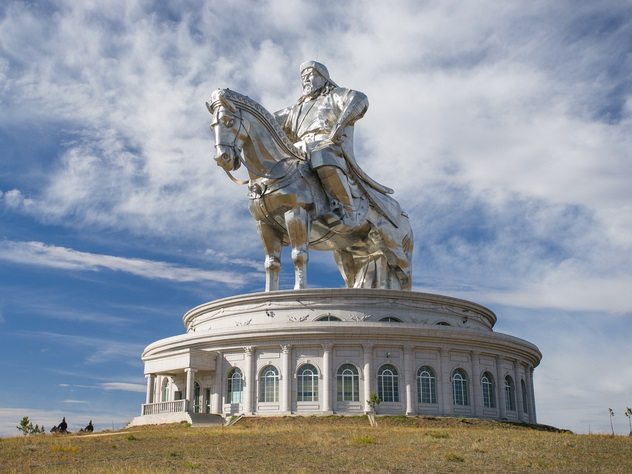 The Murderer:
The Murderer:
Conquering much of the known world makes you a pretty memorable guy. From East Asia to Central Europe, Genghis Khan’s Mongol armies swept away all resistance before them. The man at their head, a cunning warrior and resourceful leader, also had a cruel streak running through him. Even in a time when invading forces routinely mistreated defeated enemies and defenseless civilians, the Mongols under Genghis’s command gained a fearful reputation for ruthlessness. This reputation was useful for frightening enemy cities into submission without a single skirmish—but the Mongols’ bite was still much worse than their bark.
The future khan, born Temujin, was no stranger to heart-wrenching violence. Before his tenth birthday, his father had been poisoned by a rival clan. Temujin himself later killed his older half-brother in order to take charge of the family household. His most macabre achievements, however, operated on a much larger scale. Under his authority, the Mongols perfected terror as an art form.
The Mayhem:
As an expanding empire, the Mongols much preferred intact, subservient nations to smoking ruins, but they were more than willing to annihilate defiant enemies with extreme prejudice. There are many examples of wanton killing by the Mongols in these cases, but the sack of the great Silk Road city of Merv (in modern-day Turkmenistan) serves as a chilling example.
Fueled by the wealth of the Silk Road, Merv had become known known for its fine goods and scholars. Numerous libraries crowded inside Merv’s walls, and some of the greatest scientific minds of the Islamic Golden Age gathered there to develop their theories. Situated at a key oasis, it was renowned as a pearl among the desert dunes.
Unfortunately, that status also made it a target. In 1221, Genghis was in the process of conquering the region around Merv. As usual, the Khan promised death to any city that dared to defend itself. Nonetheless, Merv’s inhabitants were determined to resist. The Mongols approached the walls shepherding numerous human shields before them, prisoners from other local cities that had already fallen. It is not known whether the defenders held their fire when confronted with these innocents, but it is probable that many of the prisoners were killed either by defensive fire from the city or by the Mongols ordering them forward.
When besieging a city, Genghis’s men were known to lob disease-ridden corpses over the walls using catapults. This early form of biological warfare spread both contagion and terror among the defenders. Still, Merv’s inhabitants resisted. After the Mongols breached the walls, the citizens fought them block by block. Though the Mongols were unused to street fighting, and suffered heavy casualties as a result, they eventually prevailed. That was when the slaughter and destruction truly began—all at the khan’s command.
Most of the buildings in the city were put to the torch, including the irreplaceable libraries. The surviving inhabitants were marched out through the gates, where a small proportion of skilled artisans and young women were reserved to be sent back to slavery in Mongolia. All the rest were butchered. Ibn al-Athir, one of a handful who managed to escape, later described the scene:
If any one were to say that at no time since the creation of man by the Great God had the world experienced anything like it, he would only be telling the truth [ . . . ] a single city whose inhabitants were murdered numbered more than all the Israelites together. It may well be that the world from now until its end . . . will not experience the like of it again. [ . . . ] [The Mongols] spared none. They killed women, men and children, ripped open the bodies of the pregnant and slaughtered the unborn.
Contemporary Muslim scholars estimated the number of dead at 700,000. Many modern historians consider this an exaggeration. Merv’s prewar population has been estimated at 70,000, but this population was swollen by refugees fleeing the Mongol advance. A still mind-boggling figure of 100,000 deaths is entirely plausible.
The Monument:
Genghis Khan remains a controversial figure whose perception varies depending upon the region. In places the Mongols devastated, Genghis is remembered as an unparalleled butcher and destroyer. Those territories he united in relatively peaceful ways, like much of modern Mongolia, revere him as the courageous founder of the Mongol state. Fittingly, his most impressive monument is in Mongolia itself.
The 2008 memorial, at 40 meters (131 ft) high, is the world’s largest equestrian statue.[3] It stands on the plains east of Ulaanbaatar. In the pavilion beneath the statue, visitors can explore a museum, browse a gift shop, or try on traditional Mongolian clothing. The statue complex will form the nucleus of a planned theme park, as well.
The khan’s statue faces east, turning its back on the ruins of Merv and the countless other places his armies wiped off the map. His memorial builders say this symbolizes his triumphant return after his many victories. But the inhabitants of Merv certainly would have preferred that he never left home at all.
7 Enver Pasha And Talaat Pasha
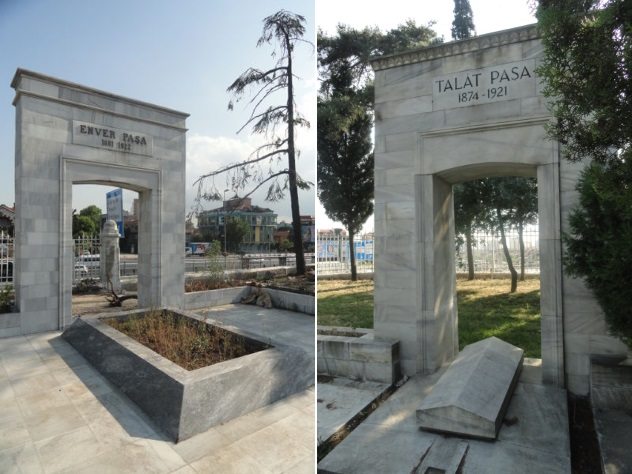
The Murderers:
Relations between Christian Armenians and Muslim Turks have never been friendly, with ethnic and religious tensions always bubbling beneath the surface. Yet these tensions peaked during the last tottering days of the Turkish Ottoman Empire. The Armenians, subjects of the empire, desired a nation of their own. Turkish officials feared this would endanger their own shaky authority. During World War I, these leaders saw a chance to shore up their regime by improving upon prior spontaneous outbreaks of anti-Armenian violence. It was the industrial age, after all. Murder could now be accomplished on an industrial scale.
For most of the 1910s, the de facto rulers of the empire were a trio known as the Three Pashas (“pasha” being an honorific): Grand Vizier Mehmed Talaat Pasha, Minister of War Ismail Enver Pasha, and Minister of the Navy Ahmed Djemal Pasha. All three were members of the progressive Young Turk Party, which seized power in a 1913 coup. The trio collectively steered the course and policies of the empire. They advocated Turkification, the purification of the Ottoman population and culture to reflect Turkish roots, excluding all minorities. On top of that, they also nursed powerful hatred for the Armenians; Talaat told a Danish diplomat as early as 1910 that, “If I ever come to power in this country, I will use all my might to exterminate the Armenians.” In 1915, Talaat and his co-rulers got their chance.
The Mayhem:
At the beginning of 1915, Enver Pasha led Ottoman forces to a disastrous defeat by the Russians at the Battle of Sarikamis, causing outcry on the home front. His government was anxious to shift the blame. Accusing the Armenians of widespread treachery was a safe bet—some ethnic Armenians did fight in the Russian army, and it played off the preexisting resentments of the majority population. This allowed the Pashas’ desire for extermination to be put into action.
The plan unfolded in measured stages. First, most of the able-bodied Armenian men, already drafted into the imperial army, were disarmed and segregated into labor battalions to reduce the chance that the executioners would face any substantial resistance. Soon afterward, these men, most of whom had fought steadfastly for the empire against its enemies, were left defenseless at the mercy of government-encouraged mobs. “Mercy” didn’t really apply; most of the soldiers were soon dead.
Next, the government turned on Armenian civilians. Evicted from their homes, many were slaughtered in the streets. Others were killed en masse through burning, drowning, poison, and gas. Those not killed were ordered on forced marches through a harsh landscape of mountains and deserts, all the way to the Ottoman province of Syria. Staggering along, they endured extreme temperatures, starvation, and brutalization from guards and local tribesmen alike. Any who survived the trek—and the plentiful robbery, rape, and murder en route—arrived at some of the world’s first concentration camps. The Ottomans provided almost nothing for their prisoners’ welfare in these camps. Starvation, a punishing climate, and disease took a frightful toll.
Within a few years, approximately one million Armenians had been annihilated.
The Monument:
For all their bloody labor, the Pashas’ regime soon toppled anyway. By 1922, the empire had broken up, replaced by the officially secular nation-state of Turkey. In exile abroad, both Talaat and Djemal were promptly assassinated by Armenian revolutionaries seeking revenge, part of a program named Operation Nemesis. Enver Pasha probably escaped their fate only by dying on his own terms first, in a headstrong attack against Soviet forces in 1922. Only a few years after the outset of the Armenian genocide, its principal architects were dead.
Turkey, however, still felt it owed a debt of gratitude to these men for their prominence in maintaining the old empire. Decades later, the Turkish government brought home the bodies of Talaat and Enver and reinterred them in a place of honor in 1943 and 1996, respectively, with the former sent as a gesture of goodwill from Adolf Hitler himself.[4] The Abide-i Hurriyet (or Monument of Eternal Liberty), a memorial complex in Istanbul, now holds the remains of two of the Three Pashas. Each grave is constructed of clean and stately stone, topped by a muscular arch, and shaded by tulip trees.
The Pashas’ impressive memorials stand far from the main sites of their atrocities in Syria and Western Anatolia. Still, of those involved in the horrific events, the Pashas are the only ones memorialized within Turkey. Since the Turkish government still insists that the Pashas’ actions were necessary for national security, it does not recognize the events as a genocide. Therefore, it has allowed no monuments to the victims to be erected within Turkey itself. The only Armenian genocide memorial in Turkey, constructed in an Armenian cemetery in Istanbul, was built under the authority of occupying Western powers at the end of World War I, but in 1922, the Turkish government dismantled both cemetery and monument, using the tombstones and other materials to build a public park on the site. Though the Pashas were dead, their desire to wipe Armenians from the face of Turkey was still alive and well.
Today, there are signs that some Turkish citizens remember the Pashas in a less-than-fond fashion. The graves at the Monument of Eternal Liberty seem to be poorly maintained, and some citizens join together in genocide memorial events each April. But for now, there remain no monuments to the dead Armenians in Turkey itself—only those honoring their killers.
6 John Mason
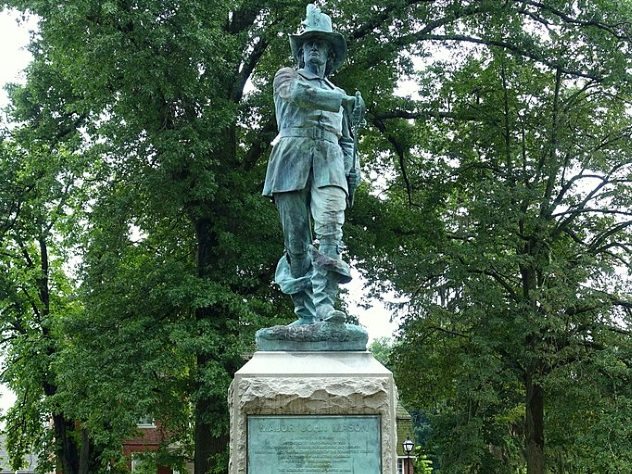
The Murderer:
Once-celebrated atrocities committed by European Americans upon Native Americans could fill an entire article by itself; many readers will be familiar with the 19th-century events at Wounded Knee, Sand Creek, and the Trail of Tears. But the history goes back much further. In 1637, only a year after the English Connecticut Colony was established at Long Island Sound, the colonists were already embroiled in a major confrontation with the local Pequots. Tensions with the Pequots, allies of England’s Dutch enemies, had been high from the start. But small attacks and counterattacks on both sides, fueled in part by a region-wide famine, escalated the ongoing violence to a new and horrific level.
Captain John Mason was an English Puritan and former soldier living in Connecticut at that time. By his mid-thirties, he was already known for his military exploits in the colonies: He commanded the first American naval force, which routed pirates from New England waters, and he helped build the first fortifications in Boston Harbor. When tensions with the Pequots reached a fever pitch, he was a natural choice to lead the Connecticut militia. Discussions among the colonial leaders produced a decision to make a disabling (and deadly) surprise attack.
The Mayhem:
In late May, Mason set out with his colonial militia and hundreds of Native American allies, who were themselves traditional enemies of the Pequots. The combined force managed to approach the main Pequot village along the Mystic River without being discovered. The village was strongly defended with a thick wooden palisade, but crucially for the coming hours, it had only two gates through which the villagers could exit.
Some of Mason’s men assaulted one of the gates, but the startled Pequots fought back with surprising effectiveness. Half of the assault party had been wounded within minutes, and they were in danger of being cut off and surrounded within the compound. To turn the tide, Mason chose a devastating tactic: He set part of the village on fire.
Such a desperate measure, used to cover the retreat of his men, could be understood as reasonable. But the next actions of the colonists reached the height of cruelty. As their native allies watched in disgusted horror, and the wind off the river fanned the flames, the militiamen blockaded the two exits of the palisade. Any Pequot who tried to flee through those entrances—man, woman, or child—was cut down by hand. Each of the over 400 Pequots inside the village faced a terrible choice: death by fire or death by sword. Mason’s second-in-command, John Underhill, later recalled:
[T]he fires [ . . . ] meeting in the center of the Fort blazed most terribly, and burnt all in the space of halfe an houre; many couragious fellowes were unwilling to come out, and fought most desperately through the Palisadoes, so as they were scorched and burnt with the very flame, and were deprived of their armes, in regard the fire burnt their very bowstrings, and so perished valiantly. [ . . . ] [M]any were burnt in the Fort, both men, women, and children, others forced out, and came in troopes to the Indians, twentie, and thirtie at a time, which our souldiers received and entertained with the point of the sword; downe fell men, women, and children.
When the smoke cleared, a majority of the Pequot tribe lay dead in and around the ruins of their village.
The Monument:
With the Pequot’s strength broken, the war ended soon after the Mystic massacre. For his actions, Mason was promoted to major; he went on to serve the colony of Connecticut for decades in a number of important governmental and military posts. Such was his stature in the colony that when official records mentioned him, they simply called him “the Major.” That respect carried forward into United States independence. More than 200 years after his death, a larger-than-life bronze statue of him was erected in the town of Mystic. The site was chosen because it was believed to be the exact spot on which the Pequot village had stood—and on which Mason had exterminated them.
The remnant Pequots in the region, who had gradually recovered their cultural and tribal identity, protested the statue and its placement from the start. Their arguments fell on mostly deaf ears until the 1990s, when Connecticut authorities reexamined the issue. What followed is perhaps the most balanced modern example of weighing old monuments’ historical value against modern standards of heroism and villainy.
A Pequot spokesman launched a petition that sought compromise. He suggested the statue be moved to an alternative location, out of respect for the massacred Pequots, and have a new inscription that honored Mason’s other considerable contributions to Connecticut, without celebrating his role in the Mystic atrocity. The original plaque had omitted anything else about his achievements, mentioning only (and glowingly) Mason’s command during the fighting.[5]
After much discussion, a consensus was reached that followed the outlines of this plan. Mason’s statue was reinscribed with a more nuanced description of his actions and moved to a location near Mason’s home in the town of Windsor. It remains there today, considered by locals to be an intentional monument to the complexities of history.
5 Hernan Cortes
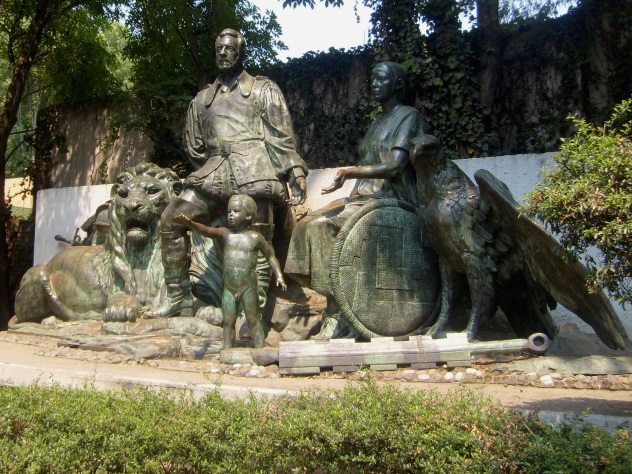
The Murderer:
Zeal is a powerful thing; overzealousness can take that power and use it for ugly ends. The conquistadors who led Spanish colonization in the Americas had zeal coming out of their ears. They came from a long line of re-conquistadors. The Reconquest of Spain to drive out its Muslim Moorish invaders had lasted 700 years, culminating in final victory in 1492, the same year Columbus discovered unknown lands across the sea. Over the course of those seven centuries, Spanish militarism and Catholicism had been fused into a robust and uncompromising hammer—and when they landed in America, almost everything looked like a nail.
Hernan Cortes came to Spanish America in his teens, and he quickly made a name for himself in the colonies at Hispaniola and Cuba. Quick wits, personal courage, and keen ability enabled a fast rise in colonial society. By age 20, he owned a large estate and numerous slaves, and before he was 30, Cortes was serving as mayor of the thriving Cuban capital of Santiago. Yet he was unsatisfied. The mainland of North America, a newly discovered land called Mexico, beckoned. There, Cortes decided to carve out more territory and glory for himself. His venture would yield enormous wealth, enormous upheaval, and enormous slaughter.
The Mayhem:
Volumes can be (and have been) written about Cortes’s conquest of the Aztec Empire in Mexico, with some historians arguing that the entire enterprise deserves to be remembered primarily as an atrocity. Debate continues to this day. A narrower focus, however, on the Mexican city of Cholula, provides a clear-cut example of mass murder on Cortes’s part.
Cortes, after allying with some native peoples oppressed by the Aztecs, was alternately fighting and negotiating his way inland toward the Aztec capital. The bustling city of Cholula stood in his path. With a population around 100,000, the city was an important trade and religious nexus in Central Mexico. Its goods traveled far and wide, and worshipers came from miles around to visit its great pyramid, Tlachihualtepetl (the largest pyramidal structure in the world, by volume). Its leadership welcomed the Spanish peacefully, though Cholulan distrust of the Spaniards’ native Tlaxcalan allies meant the allies had to remain outside the city. Unfortunately for the Cholulans, their most dangerous foes were already inside the walls.
According to some reports, Cortes expected treachery, noticing hints that the Cholulans were perhaps preparing to ambush the Spanish. Historians have also pointed to Cortes’s need to frighten the Aztec emperor into submission by making a violent example of one of his cities. But whatever the reasoning, Cortes quickly gathered the Cholulan nobility in one vulnerable place, the courtyard of the great temple. He made sure they were unarmed.
After a speech accusing them of betrayal, Cortes proceeded to execute the king of Spain’s penalty for traitors: massacre. The crowd of defenseless noblemen, priests, merchants, and their families was set upon by the fearsome Spanish soldiers, who hacked and slashed their way through the assembled humanity with relish. Cholulans soon were dying by the hundreds, victims of either Spanish steel or the stampeding feet of their panicked neighbors. The disaster was completed by the Tlaxcalans, who now rushed into the city to destroy their traditional enemies.
By the time the Sun set, thousands of Cholulan corpses lay amid the rubble, with much of the remaining population fleeing before the combined Spanish-Tlaxcalan onslaught. The great city would never recover.
The Monument:
Cortes went on to a celebrated career of conquering new provinces for the Spanish Empire, as well as administering several as a high royal official. While his administrations were also marked by scandal and arrogance, many in the Spanish sphere venerated his success against very long odds. Several monuments to him exist, including one near his birthplace in Medellin, Spain, which was vandalized with red paint in 2010.
Most controversial, though, are depictions of Cortes in Mexico itself. Many Mexicans have resisted monuments to the conqueror, protesting their erection and attempting to destroy them when possible. Yet in the 1980s, Mexican president Lopez Portillo insisted on memorializing Cortes’s beneficial contributions to “mestizo” culture, a fusion of Spanish and Native American cultures. After several defeated attempts, he succeeded in having a sculpture named El Monumento al Mestizaje placed in the town square of a Mexico City suburb.[6] Far from the victorious figure of the Medellin statue, the Monumento al Mestizaje depicts an unheroic scene of Cortes, his mistress Malinche, and their son Martin, one of the first mestizo families, sitting quietly together.
Even this subdued depiction failed to escape the wrath of the descendants of Cholula and the rest of Mexico’s native places. Protests raged until Portillo agreed to move the statue to an out-of-the way park, where it has remained ever since. At least so far.
4 Vlad Tepes
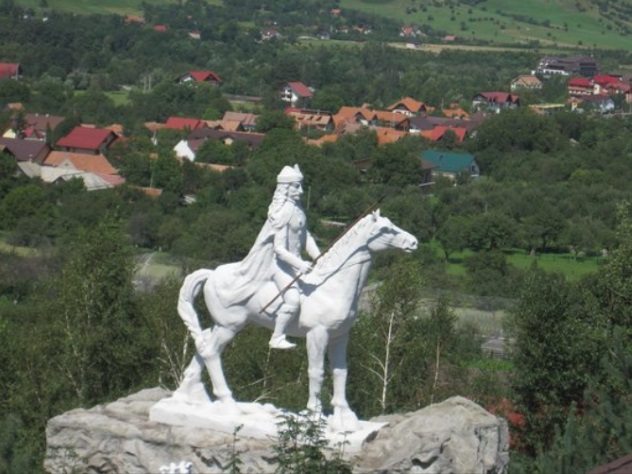
The Murderer:
Before the Dracula vampire legend, the man behind it was known simply as Vlad III of Wallachia or, more sinisterly, as Vlad Tepes (“the Impaler”). While nothing in history suggests he was a bloodthirsty member of the undead, Vlad the man was consumed by a lust for power—and a willingness to commit wholesale cruelty in pursuit of it.
In the mid-1400s, the Balkan province of Wallachia was at the center of numerous upheavals. Wallachian nobles warred with each other for supremacy, the kingdom of Hungary to the north sought to regain its former province, and the Ottoman Empire to the south looked to add Wallachia to its domains. Vlad III’s father, Vlad II, emerged in the power struggles as voivode (prince) of Wallachia, managing for a while to maintain his position in the dangerous atmosphere. For a number of years, the Ottomans held two of his sons—including the future Vlad III—in prison as hostages, ensuring that Vlad II kept paying them tribute. Prison cannot have been good for the future prince’s psyche.
The Mayhem:
After his father died at the hands of Hungarian invaders, Vlad III began to pursue the throne on his own. In dizzying revolving-door diplomacy, he at various times allied with and fought against Ottomans, fellow Wallachian noblemen, and the Hungarians, being twice removed from power but always returning again. Understandably, he was terminally insecure about the safety of his throne. Out of a desire to cement his authority, he turned to mass murder.
His methods first came on display in a trade dispute with Saxon settlers in Transylvania. When the Saxons resisted his domination, Vlad had their villages burned to the ground, with many Saxons perishing in the flames. Those who survived the blaze were executed by a devious multitude of other methods. Not even infants were spared.
His favorite means, that which gave him his nickname, was impalement. The Ottomans had practiced it as a method of torture and execution for a long time, and Vlad had undoubtedly witnessed it during his imprisonment. It proved a gruesome inspiration. Long, sharp poles were rammed into the victims’ bodies, piercing them from front to back (or back to front). The poles were then erected as a warning, leaving the victims to die in agony over the course of hours or days. Few who saw such a sight ever forgot it.
Turning his wrath on the Ottomans when they fought against him, Vlad raided their territory with horrific efficiency. As he wrote: “I have killed men and women, old and young . . . 23,884 Turks and Bulgarians without counting those whom we burned alive in their homes or whose heads were not chopped off by our soldiers . . . ” Soon afterward, Vlad petitioned the Hungarian king for military help against the Ottomans. As proof of his sincerity, he sent a representative sample (two sacks full of severed heads, noses, and ears) along with the message.
Vlad’s own native citizens were not safe, either. Whether they were suspected of disloyalty, had committed criminal acts, or had simply displeased the prince in some way, Vlad had no qualms about quickly and brutally executing them. These killings had a double purpose—they were intended both to convince his population that crossing him meant death and to impress foreign enemies that he would be merciless if they attacked him. The Ottoman imperial army, approaching Vlad’s capital to punish him for his raids, was turned back by this psychological warfare. As one Turkish chronicler put it:
In front of the wooden fortress where he had his residence he set up at a distance of six leagues two rows of fences with impaled Hungarians, Moldavians and Wallachians (and Turks we may add). In addition, since the neighbouring area was forested, innumerable people were hanging from each tree branch . . .
Witnesses numbered the corpses in the “forest of the dead” at 20,000. The sultan himself, at the head of the army, ordered a withdrawal. Reportedly, he said in amazement that there could be no victory against such a man as Vlad, who commanded with such absolute power and viciousness.
The Monument:
Even though Vlad’s campaign of terror worked to hold off the Ottomans, it could only work for so long against his own people. After years of living in terror of their prince, a critical mass of Wallachians eventually deserted Vlad, siding with his enemies. The Ottomans backed a rival Wallachian claimant to the throne, and the combined forces killed Vlad in battle. His corpse was torn to pieces.
While Vlad did not survive into old age, his country did. His ruthless quest to secure his throne had also secured breathing space for the Wallachians. Wallachia maintained its independence from its larger neighbors and united with Moldavia to form the nation of Romania in the 1800s. In the nationalist sentiment that followed, many Romanians celebrated Vlad as a brutal but effective guardian of their people. Such a figure clearly deserved a monument.
Outside Bran Castle, an impressive white statue of Vlad looms over the landscape, showing the medieval prince as lord of all he surveys.[7] On horseback, in a warrior’s attire, Vlad looks every inch the stainless national hero. But the Romanian word “Tepes” on the pedestal gives a hint at the wider truth.
3 John Doyle Lee
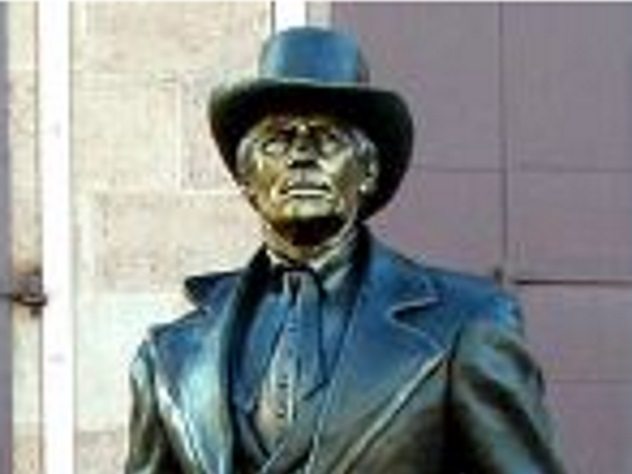
The Murderer:
Mormons today are often viewed as benign, placid, and borderline pacifistic—yet the early history of the Church of Jesus Christ of Latter-Day Saints contains a lot more violence than one might expect. Joseph Smith, the founder of the church, died at the hands of an anti-Mormon mob, along with his brother. For self-defense, the Mormons formed their own armed militias. This militia force, determined to preempt any more anti-Mormonism, wound up committing their own atrocity in turn.
John Doyle Lee was a prominent figure in the early Mormon Church, a friend of Joseph Smith and adoptive son of church president Brigham Young. His efforts in establishing the Mormons in their new homes in Utah, after they had moved westward to escape US interference, earned him a high place in the state’s history. The great degree of trust placed in him resulted in his elevation to the rank of major in the Mormon militia—a promotion that would eventually put him in position to commit a massacre.
The Mayhem:
In 1857, when a wagon train from Arkansas, the Baker-Fancher party, began crossing Mormon territory en route to California, local Mormons grew extremely anxious. Prior concerns about the US government staging an attack on the Mormon settlements had led Brigham Young to declare martial law. This, added to the general Mormon distrust of strangers, caused Mormon leaders in Southern Utah to apparently regard the Baker-Fancher party as a threat and a possible infiltration force cooperating with federal authorities.
Accordingly, those leaders hatched a plan to drive off or eliminate the emigrants by enlisting local Paiute natives to attack them, reinforcing the Paiutes with Mormon militiamen dressed in native clothes. This way, Utah would be rid of the interlopers, and the casualties could be blamed on the Native Americans. The conspiracy laid, the Mormons mustered their forces and attacked the wagon train at Mountain Meadows, in present-day Washington County, Utah.
The Arkansans fought back with unexpected vigor, however, and the fight settled into a siege of the emigrants’ encampment. Things went downhill fast when Major Lee and his men began to suspect their true identities had been recognized. Fearing discovery and retaliation by US authorities, they decided to make sure none of their adversaries escaped to tell the tale.
Lee and some of his men removed their disguises and openly approached the besieged emigrants, claiming to have negotiated safe passage for them through the Indian encirclement. Thirsty and exhausted, the Arkansans agreed, accepting an escort of one Mormon militiaman per person. They felt safe. Then, at a prearranged signal (Lee’s shout of, “Do your duty!”), each escort turned on his charge.
Muzzles flashed, knives were unsheathed, and musket barrels became clubs. Neither man nor woman escaped. By some accounts, two teenage girls temporarily escaped down a ravine, only to be hauled back, raped, and added to the growing body pile. The only survivors were 17 children aged six and under—those not killed in the confusion. Lee and his officers had decided that children that young wouldn’t be able to reveal what happened.
Within a week, the orphans had been distributed among Mormon families, an auction had been held to sell off the personal effects of the deceased, and wild animals were already rooting through 120 shallow graves at Mountain Meadows.
The Monument:
Major Lee was the only member of the perpetrators ever brought to justice, and it took over a decade for a trial to take place. That justice, though leisurely, was strict: Lee was convicted and shot to death by a US Army firing squad. Fittingly, the execution site was Mountain Meadows, though Lee received a much more respectful burial than he gave the Baker-Fancher party.
The major went un-memorialized until 2004, when the Utah city of Washington commissioned a local sculptor to produce a 2.1-meter (7 ft) bronze statue of him. The intent was to honor Lee’s role in the founding and settling of the state of Utah. Yet, while the statue lay in storage, a storm of public debate over Lee’s murderous record delayed its installation. Finally, the sculptor bought it back from the city and erected it at his own private gallery, where it remains on display today.[8]
2 Jean-Jacques Dessalines
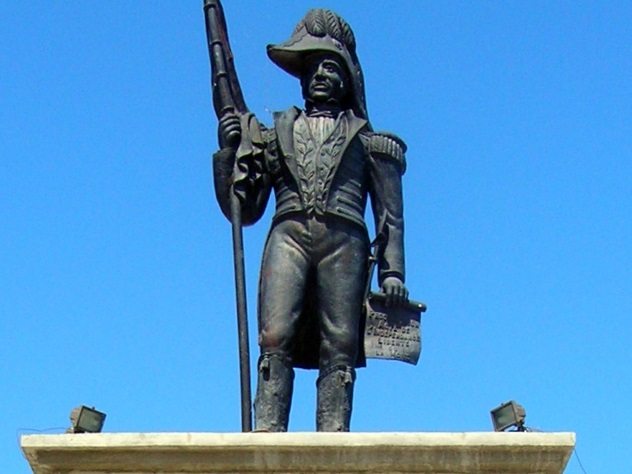
The Murderer:
Like Nat Turner, Jean-Jacques Dessalines was a former slave exacting retribution on the white slave society that had brutally exploited him. Unlike Turner, Dessalines acted with systematic ruthlessness, from a newfound position of absolute authority.
In 1804, the original slave rebellion in Haiti against French colonization was only 13 years old, yet it had achieved extraordinary success. Through a confused dust cloud of cyclical alliances and betrayals between black slaves, mixed-race creoles, white colonists, and representatives of the French revolutionary government, a coalition of blacks and creoles had finally emerged to control the island. Even though many whites had been killed or fled after earlier French defeats, a substantial white minority population remained in Haiti.
Jean-Jacques Dessalines had done well by the revolution. The 1790s had seen him rise from a lowly laborer in plantation sugarcane fields to one of the top generals among the Haitian revolutionaries. He led his troops with great personal courage in numerous battles. He also became known for his heavy-handed tactics, burning enemy villages and taking remarkably few prisoners. After collaborating with the French to hand over his rival, fellow revolutionary Toussaint L’Ouverture, Dessalines became the supreme leader among the Haitians. He led them to a final victory over the French in 1803. Soon afterward, he proclaimed the Empire of Haiti, with himself at its head.
Most whites unwilling to live under black Haitian rule had evacuated with the defeated French army; the approximately 4,000 whites remaining seem to have chosen deliberately to stay. Yet Dessalines considered this remnant to be a cancer that could threaten the fragile new Haitian state—and he vowed to carve it out.
The Mayhem:
In early 1804, rumors began circulating that the remaining whites wanted to travel back to Europe and stir up sympathy for an invasion to retake the island and reimpose slavery on the Haitians. Dessalines and his ruling council immediately forbade any whites from leaving the country. That was only a temporary solution, however. A final one was not long in coming.
The emperor sent out an order to all his garrisons, proclaiming that all whites should be killed as quietly as possible, using blades and clubs, to avoid alerting other victims that the killings were taking place. Apart from a few show executions, though, the orders were not widely obeyed. Some of the Haitian soldiers held back out of mercy; others may have considered the whites (who had until recently run the colony’s economy) to be worth more alive. Either way, the restraint only delayed the colonists’ doom.
Aware that his orders weren’t being followed, Dessalines began touring across Haiti, visiting each settlement in succession. When he came to town, it spelled death for every colonist who remained.
After Dessalines and his personal guard arrived, they would order all white colonists hauled out into the streets to be massacred. An orgy of rape and murder would follow—with neither French adults nor French children being spared. When at last the violence had sputtered out, Dessalines would proclaim a general pardon for all whites in the town who had hidden to escape the slaughter. This was only a ruse to draw them out, however. Any who emerged from hiding were quickly killed as well.
In some instances early on, the majority of white women were spared. Then some of Dessalines’ advisors pointed out that white women could still some day give birth to white men and were therefore still a threat. Convinced by this logic, Dessalines expanded his execution order to genocidal scope. Any white women who refused gunpoint marriage to a black Haitian were put to death as well.
By April 1804, nearly 4,000 whites had died in the killing. Apart from a few captive wives and doctors, no French persons remained in the former French colony.
The Monument:
Dessalines did not last long in the volatile world of Haitian politics. He was assassinated in 1806. But his role in the nation’s independence was indisputable. In repeated surges of pride in Haiti’s accomplishments, heroic statues and busts of him were erected in Port-au-Prince, Gonaives, and even by the Ecuadorians in far-off Quito.[9]
Haitians today look back on the achievements of their revolution with justifiable pride. It was the only truly successful slave rebellion in history and the only revolution to ever succeed without external assistance. Without the skills of Haiti’s revolutionary leaders, the victorious outcome would not have been possible.
1 Nana Sahib And Tatya Tope
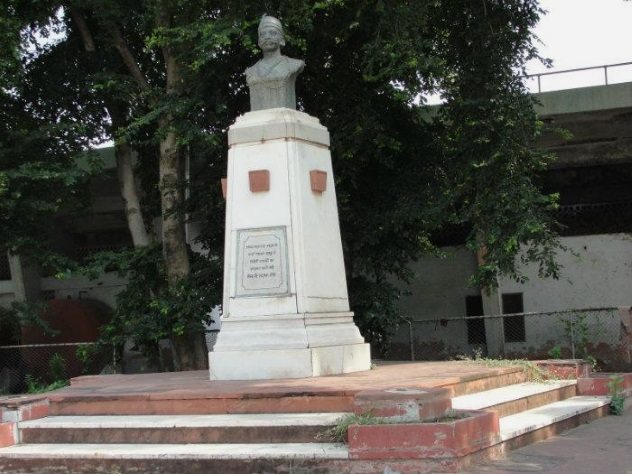
The Murderers:
In 1857, British India was a powder keg waiting to explode. The native population, infuriated by the arrogance of the imperialist British and concerned about potential threats to their continued culture and religion, rose up in revolt that spring. The ensuing rebellion claimed many lives and is known for numerous atrocities on both sides.
Nana Sahib, the heir to an Indian state absorbed by the British domain, was initially caught off guard by the rebellion. Having befriended many of the well-to-do British stationed at the city of Cawnpore (now Kanpur, Uttar Pradesh), he was reluctant to immediately throw his full support behind the conflict. Yet his enthusiastic supporters were eager to restore Indian self-rule. They, including his lieutenant and best tactician Tatya Tope, urged him to definitively take a side. Eventually, Nana Sahib did, to devastating effect.
The Mayhem:
The colonial European civilian population at Cawnpore fled to the protection of the small British garrison, housed in a barely defensible (and largely open-air) compound known as the Entrenchment. For weeks, Nana Sahib’s forces pounded the place mercilessly with cannon and musket fire, indiscriminately killing both armed Englishmen and noncombatants by the hundreds. Finally, the British commander accepted a cease-fire offer from Nana, under which all his remaining people could evacuate to British-held territory.
The bleary-eyed survivors marched down to the river to board boats, only to find Nana Sahib’s men, led by Tatya Tope, lying in wait. The rebels sprang a vicious trap, again annihilating the British, regardless of age or sex. Hundreds more died, whether burned alive in the boats, drowned in the Ganges River, or shot and stabbed at the water’s edge.
Tatya hoped that the atrocity would force Nana to stop straddling the fence between opposing the British and appeasing them. It did. After this, there was no going back. Nana Sahib would spend the rest of his life opposed to the British.
Nearly all the remaining British men died at the river or were summarily executed. But approximately 200 women and children were spared to serve as hostages and herded into a small house in a city known as the Bibighar. They remained there, wretched and wracked with disease, for nearly three weeks, until the approach of a British relief force. With that, someone in the Indian leadership, most commonly believed to be Tatya Tope, ordered the elimination of the captives. Wives, mothers, fiancees, children, and newborn infants fell shrieking under the cleavers of six butchers assigned to the task.
When the British soldiers arrived, a day too late, all they found was an empty house coated in tresses of hair and gallons of congealing blood—and a deep well in the yard outside, crammed to the brim with dismembered body parts.
The Monument:
British outrage at the treachery and massacres at Cawnpore grew into a storm of counter-atrocities as they laid waste to much of the surrounding area. Nana Sahib and Tatya Tope fought on for months but ultimately could not overcome their foes. Tatya was captured by the British two years later, tried for his part in the massacres, and promptly executed. Nana disappeared into the jungle-covered mountain ranges on the Nepalese border, where he is presumed to have died in later years. Debate still rages about the precise degree to which either man planned the massacres in advance. Still, like the British generals they fought against (and Nathan Bedford Forrest above), they bear an officer’s responsibility for the atrocities that took place under their command and for failing to halt the bitter violence once it began.
Monumentation at Cawnpore/Kanpur has unfolded in two phases. In the first phase, the victorious British erected a memorial park at the site of the Bibighar well, focused upon remembrance of the innocent victims. The centerpiece was a mournful angel figure, holding palm fronds to signify peace, standing atop the well itself. An Anglican cathedral, likewise dedicated to the victims, was also built in the city. The Memorial Well became almost a pilgrimage destination for the British and was soon the most-visited spot in all of British India.
All that changed with Indian independence in 1947. The new government promised the withdrawing British that their cultural sites would be protected, but the Memorial Well was quickly vandalized by locals. Soon afterward, government officials dismantled the entire memorial complex. Some of the marble ornamentation was simply destroyed; the angel was evicted and banished to the garden of the cathedral. Many locals apparently viewed the memorial as an imperialist eyesore.
The site is now occupied by Nana Rao Park, a civic green space dedicated to Nana Sahib’s memory and celebrating his status as a freedom fighter. Kanpur tourist websites praise the park’s fine plant nursery, swimming pool, and opportunities for badminton and yoga. When they discuss the site’s history at all, most emphasize the British atrocities that took place in and around Cawnpore. The most one site can say about the parallel Indian atrocities is a cryptic misdirection: “On the morning of June 27, a large British column led by General Wheeler made their way to the banks of the River Ganga where Nana Sahib had arranged 40 boats for their journey. [ . . . ] It led to a certain set of historical events, which made the legacy of Nana Sahib, a memorable one [sic].”[10]
Statues of other Indian nationalists dot the park, including an impressive martial bust of Tatya Tope. His likeness has replaced the angel atop the blood-soaked well that Nana and Tatya made infamous.
It is left for the reader to determine whether these changes are for the better.
David F. Ellrod currently resides in Maryland with his wife, three daughters, and one very excitable dog.
Read about more surprising monuments around the world on 10 Unusual Statues And Monuments From Around The World and 10 Weird And Wonderful Animal Monuments.
